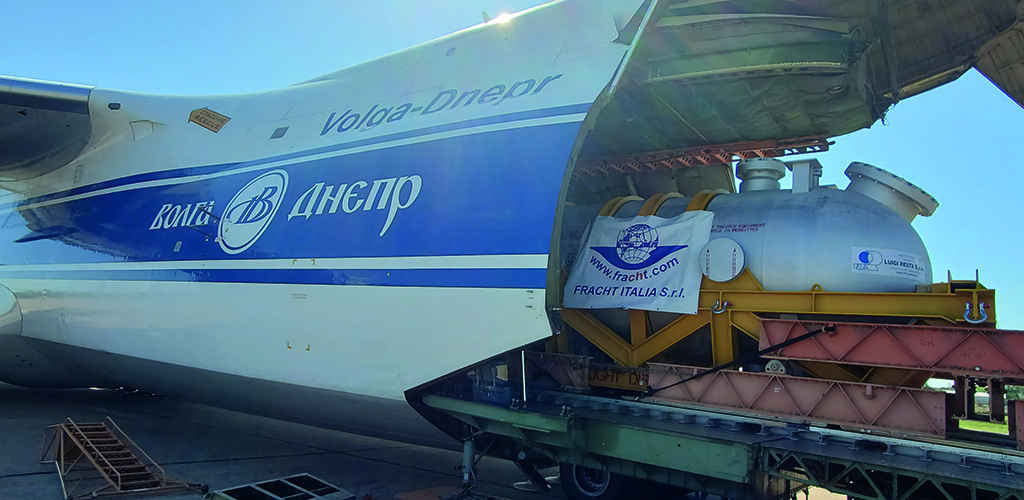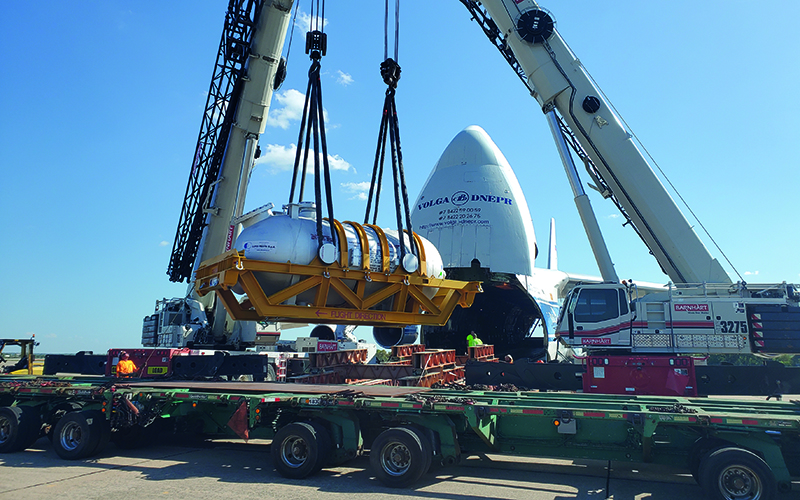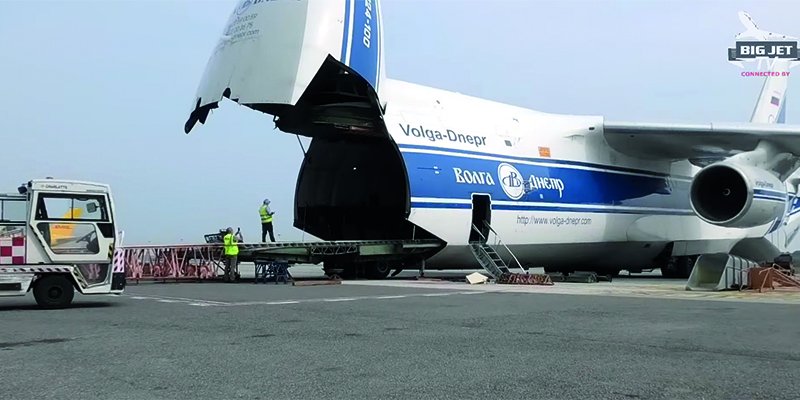Tweaks to Reduce Weight Give Greater Flexibility

By Malcolm Ramsay
 Delivering breakbulk cargo by air is invariably a complex challenge, but one that is normally less visible to the public than ground transport. The relative lack of road closures and out-of-town location of airports mean that the efforts of many airfreight projects go unobserved.
Delivering breakbulk cargo by air is invariably a complex challenge, but one that is normally less visible to the public than ground transport. The relative lack of road closures and out-of-town location of airports mean that the efforts of many airfreight projects go unobserved.
With an ambition to address this, airfreight specialist Volga-Dnepr Airlines and logistics group Fracht FWO recently collaborated on a forwarding project and shared behind-the scenes footage of the process, raising awareness of daily all-cargo operations.
 “The AN-124-100 fleet often generates a lot of interest wherever they go, and we recognize the achievement that customers and viewers feel in seeing such a unique aircraft,” Ekaterina Andreeva, commercial director at Volga-Dnepr Airlines, told Breakbulk. “To date, this has been our longest livestream, and was perhaps refreshing for reviewers to see how the aircraft is loaded from start to finish. It provided a greater understanding of the length of time needed to load heavy/oversized items due to the necessary precision.”
“The AN-124-100 fleet often generates a lot of interest wherever they go, and we recognize the achievement that customers and viewers feel in seeing such a unique aircraft,” Ekaterina Andreeva, commercial director at Volga-Dnepr Airlines, told Breakbulk. “To date, this has been our longest livestream, and was perhaps refreshing for reviewers to see how the aircraft is loaded from start to finish. It provided a greater understanding of the length of time needed to load heavy/oversized items due to the necessary precision.”
The cargo moved for this project was an outsized boiler, weighing 83 tonnes, which Fracht was contracted to move from Milan to Iowa. Chris Schumacher, vice president of airfreight at Fracht, explained: “One of our VIP U.S.-based customers asked us for pricing to deliver a single boiler from the manufacturer in Italy to a jobsite in Iowa.” Building on a long history of cooperation with Volga-Dnepr, the firm then approached the airline to discuss charter services, scheduled services, and logistics services too.
Headquartered in Basel, Switzerland, Fracht provides a range of breakbulk logistics services, with a history of project forwarding stretching back more than 50 years.
“Fracht USA/Italy approached Volga-Dnepr on a charter requirement for a heavy and oversized boiler from Milan to Nebraska. Due to Volga-Dnepr’s extensive fleet, including AN-124-100s, IL-76TD-90VD, B747Fs, B777F and B737Fs, we have a strong partnership with the global Fracht team, who we have collaborated with on several projects,” Andreeva said.
 Aware of the risks of disruption in global supply chains and the need for detailed pre-planning, the two partners began preparation two months ahead of delivery. For Volga-Dnepr, the first step in this process was to brief their dedicated load planning and design team and begin narrowing the choices for optimal cargo transportation. This included not only safety compliance of cargo, but also modeling solutions to optimize lead times for the customer and reduce costs.
Aware of the risks of disruption in global supply chains and the need for detailed pre-planning, the two partners began preparation two months ahead of delivery. For Volga-Dnepr, the first step in this process was to brief their dedicated load planning and design team and begin narrowing the choices for optimal cargo transportation. This included not only safety compliance of cargo, but also modeling solutions to optimize lead times for the customer and reduce costs.
“In this case, the Volga-Dnepr load planning team used our own dedicated software CargoPlan to accurately review the load plan itself, which includes 3D modeling for evaluation,” Andreeva said.
Headquartered in Moscow and also with its own office in Ulyanovsk in the Central European part of Russia, Volga-Dnepr Airlines specializes in air charter services via a fleet of An-124-100/150 and IL-76TD-90VD (Stage IV) cargo aircraft.
Custom Cradle Manufactured
Having modeled the boiler in detail, the teams then faced an additional challenge as it was calculated that the unit would need additional support during the flight.
“The cradle was needed to hold the boiler in place, while it withstood the ‘G’ forces associated with air travel. With the load being at the max weight of what the Antonov could transport, even the slightest shift of the cargo could have caused major issues. Volga-Dnepr created the design of the cradle and the fabricator of the boiler sourced and built the cradle from scratch,” Schumacher said.
Full technical drawings and specifications of the boiler were the starting point for this design process, with Volga-Dnepr’s design team using SolidWorks and AutoCad, together with Ansys, to perform a stress analysis to check for tolerances inside the aircraft cabin. This allowed the team to check correct weight distribution and for engineers to carry out strength analyses based on cargo floor structure.
“Although safety is our primary purpose for cradle designs, we also look at what materials can be widely sourced by our customers for time management and cost benefits,” Andreeva said. While customers may design cradles themselves, the Volga-Dnepr team’s experience and knowledge of loading parameters for the various aircraft in its fleet is advantageous, she added.
“Once we present out initial design, we then work in collaboration with all concerned parties (often engineers from both charterer/manufacturer’s sides) to ensure everything matches with their requirements, before in turn creating the final customized cradle design for production,” Andreeva added.
With the calculations completed, the partners agreed on a route that would take the valuable cargo from Milan in the north of Italy to Lincoln, Nebraska, with tech stops planned for Liege, Keflavik, Gander and Bangor.
Payload Limitations Prompt Rethink
For this project, one of the biggest challenges for the flight was the maximum payload limitations en route, which in this case was 113 tons.
“At first, in consideration of the cargo piece itself, plus the weight of the cradle and our standard aircraft loading equipment, the total weight was 112.5 tons for loading, which can be risky should there be any unplanned weight deviations,” Andreeva said.
Opting to avoid the use of one of the airlines Volga-Dnepr AN-124-150 aircraft – which is often limited in availability and could result in higher costs due to global positioning – the team opted instead to optimize the weight of the cargo and turned to Fracht to reconfirm the weight using a lift at the shipper’s premises to avoid any surprises.
 Having accurately re-weighed the cargo, Volga-Dnepr chose to reduce the payload by using its own proprietary ramp-extension equipment plus a special spreading beam that was flown in from Ulyanovsk, Russia. This adjustment to the project move allowed the partners to reduce the overall payload by 8 tons, allowing for greater scheduling flexibility with the AN-124-100 aircraft – and also reducing costs for the customer.
Having accurately re-weighed the cargo, Volga-Dnepr chose to reduce the payload by using its own proprietary ramp-extension equipment plus a special spreading beam that was flown in from Ulyanovsk, Russia. This adjustment to the project move allowed the partners to reduce the overall payload by 8 tons, allowing for greater scheduling flexibility with the AN-124-100 aircraft – and also reducing costs for the customer.
As well as loading considerations, the weight of the payload also affected the route planning for the project as extra fueling was required to ensure safe transit.''“We were max weight of the Antonov, so we needed to make an extra fuel stop in Bangor,” Schumacher noted.
The customer’s final destination requirements for delivery to Nebraska also placed further restrictions on the route, as there was a limited selection of airports with the infrastructure necessary to accommodate an aircraft with such a heavy payload.
Lincoln Airport was chosen as the destination airport due to its capacity to handle the freight, but as it had no international customs facility it was necessary to arrange for clearance at another U.S airport. As a result, the planned tech stop in Bangor allowed Fracht to process U.S. customs clearance upon arrival.
Global Streaming Success
With the route finalized the partners began final preparations to begin loading in Milan as well as coordinating with a film crew and IT teams to capture the operations for the live stream.
“We partnered with Jerry Dyer at Big Jet TV – who does this regularly – to capture this one live and hope to partner with him again for future shipments,” Schumacher said.
On the morning of the move itself, cameras were in position early, the loading procedure in Milan went ahead using ramp-extension equipment for loading through the aircraft nose cargo door. This process required cargo pieces to be lifted on to it using mobile cranes.
“For this flight two cranes were used to ensure flat alignment against the slope of our ramp-extension equipment. This method is often used in the case of long/heavy pieces to ensure precision control,” Andreeva explained.
Some additional measures were also required to compensate for the tight space onboard the aircraft, with Schumacher noting that “the position of the bolts on the boiler and cradle made in difficult to loosen/tighten them. We had to use special wrenches to be able to fit in a tight space, in order to secure the boiler to the cradle.”
With Big Jet TV recording for more than five hours, the resulting livestream was viewed by more than 2,000 people worldwide, providing an unprecedented insight into the challenges and processes required to load such a large and heavy cargo.
Calling the project, a “live Mega Load operation,” Dyer of Big Jet TV complemented the teams: “With the expected challenges, the boiler was loaded flawlessly by Volga-Dnepr’s own ‘traveling’ team of loadmasters.”
“Live streaming on future projects depends on the customer and the airport of course. It is also a feature that we will look at when international industry events return again,” said Charlotte Willoughby, business development manager at Volga-Dnepr. “We have also similarly welcomed Sam Chui (who has his own aviation Youtube channel) on board, with the video grossing 3.3 million views to date, showing just how much excitement there is around the AN-124-100. Prior to the pandemic we would also offer local logistics communities in-person tours of the aircraft for better understanding of its capabilities and hope we will be able to resume doing so soon.”
With the cargo safely stowed, the aircraft then made its way to Lincoln, Nebraska, where unloading took place ahead of onward road transport to the final destination, a plant in Sioux City, Iowa.
There was one further challenge to overcome at this stage: here, Fracht encountered a lack of police escort availability. Schumacher explained that the police were short staffed due to the pandemic and that there was a back log of oversized truck loads moving across Nebraska. But close coordination with them allowed the team to find a suitable time to travel and keep the project moving.
The livestream of this move can be viewed here: https://www.youtube.com/watch?v=388jgStcNzBased in the UK, Malcolm Ramsay has a background in business analysis and technology writing, with an emphasis on transportation and ports.
Based in the UK, Malcolm Ramsay has a background in business analysis and technology writing, with an emphasis on transportation and ports.
Photo 1: The livestream allowed for greater understanding of the length of time needed to load heavy/oversized items. CREDIT: VOLGA-DNEPR AIRLINES
Photo 2: Ekaterina Andreeva, commercial director, Volga-Dnepr Airlines
Photo 3: A specialist cradle was designed by Volga-Dnepr. CREDIT: VOLGA-DNEPR AIRLINES
Photo 4: Jerry Dyer at Big Jet TV created the five-hour livestream of the load.
